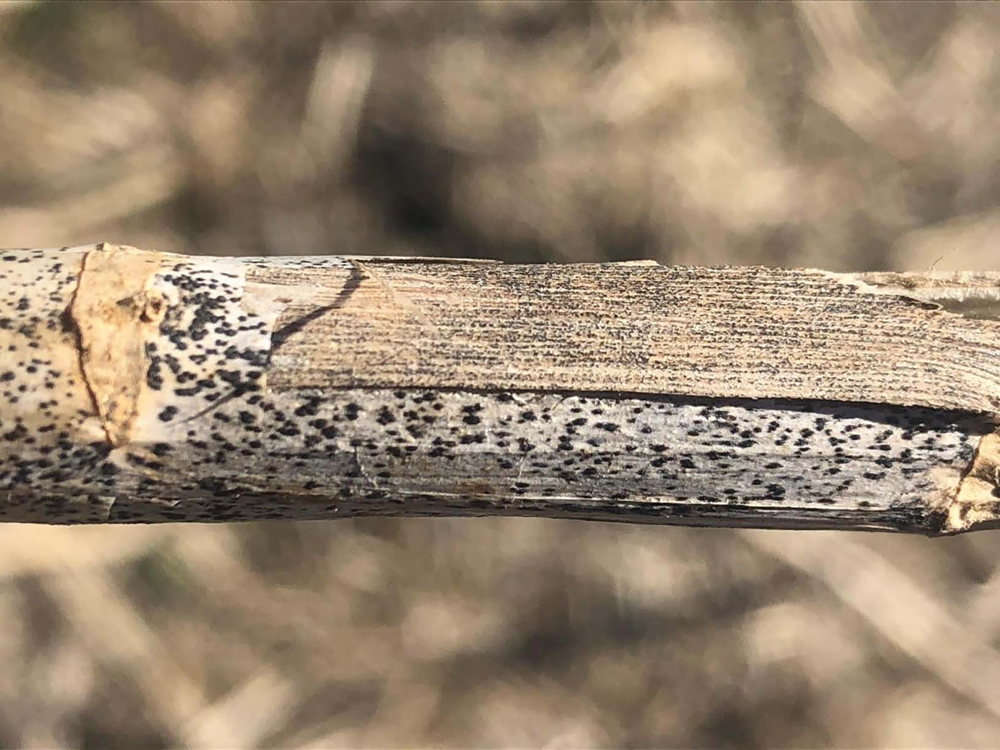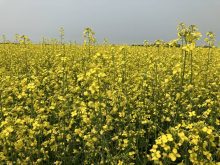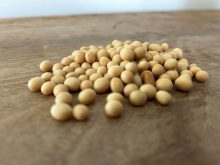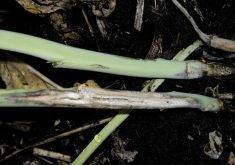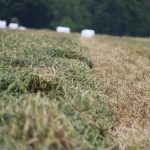Conditions weren’t ideal for verticillium stripe this year but the Canola Council of Canada says growers should stay alert when it comes to the disease.
“Verticillium stripe is a soil-borne pathogen and it overwinters in the soil,” said Courtney Boyachek, agronomy specialist and verticillium stripe lead with the council. “Last year was a bad year for infection, and the inoculum is still there. It’s something that we’re keeping in mind for this year, even though conditions are better.”
Verticillium stripe was first detected in Manitoba in 2014, the first North American case of the disease in an oilseed crop. Since then, it has been rising to yield-damaging levels in Manitoba and eastern Saskatchewan and is now found in all growing regions across the Prairies.
Read Also

Hail research hopes to benefit potato growers
Alberta research scientist measures hail storm and heat dome affects on potato crops
“Over the last couple of years, infection levels have been high,” Boyachek said. “But last year was kind of the perfect storm for verticillium. So, it was pretty widespread across Manitoba and started to creep into Saskatchewan.”
Last year, cases were especially bad in the southwestern corner of Manitoba and southeastern Saskatchewan. Since the fungus is soil-borne, farmers in those areas started the year with potential for a severe outbreak.
Fortunately, 2023 weather may have mitigated the issue. Verticillium stripe flourishes in hot, wet conditions and infects plants during flowering.
“We did have adequate moisture in the spring, but we didn’t see any excess moisture,” Boyachek noted. “It did get hot, but it got hot before flowering. We saw a cooler flowering period…”
She says it’s too soon to know infection rates this year.
“We start to see it at 60 per cent seed colour change, so we’re still a little bit early to be noticing any symptoms.”
Harvest is the ideal time to scout for verticillium stripe because symptoms are most obvious.
The canola council’s messaging has ramped up in recent weeks so farmers will think about verticillium stripe as they prepare to take crop off the field. It has put out scouting tips and identification and symptom guides to help farmers distinguish it from blackleg and sclerotinia. Misdiagnosis is a common problem between the three diseases, and the same field can be infected by more than one of the three at a time.
Manitoba Canola Growers members who think they may have discovered verticillium stripe can get free testing through the Pest Surveillance Initiative, which uses DNA-based tools to single out the race or pathotype of detected diseases.
No answers
If testing does confirm the disease, there are no easy solutions. No fungicide or soil treatment has proven effective on verticillium stripe and no resistant variants have yet been developed.
“Once verticillium is there, there’s really nothing that you can do,” said Boyachek.
Accurate identification is all about managing infections in the future and avoiding spread.
That could require steps to keep the soil, and therefore the pathogen, in place. The canola council website recommends two- or three-year breaks between canola crops as good disease management in general, but warns that verticillium microsclerotia can remain viable for many years.
There is no good data that correlates infection rates with yield loss and profitability.
“We’re still not 100 per cent sure of the yield impacts of verticillium. We just don’t know those numbers quite yet,” said Boyachek.
Verticillium stripe symptoms
The Canola Council of Canada flags several verticillium signs:
Stem striping
When the crop is full height, but still green, infected canola plants will often have a two-toned stem — half healthy and green and half discoloured and drying down. This is where the disease gets its name.
Leaves can show similar symptoms: healthy on one side, diseased on the other.
This is one way to differentiate verticillium stripe, since farmers will not see stem or leaf striping with blackleg or sclerotinia stem rot. Sclerotinia will cause stem discolouration but it will not stripe half the stem.

Stem cross-section discolouration
Verticillium stripe infects roots and enters the plant’s vascular system. Verticillium hyphae (branching filaments that make up the mycelium of a fungus) and conidia (asexual spores) fill up the vascular system, giving the stem cross-section a greyish colour.
This is easily confused with blackleg. There are two main tips to distinguish the pathogens. With blackleg, stem tissue infections tend to be darker and cause distinct wedge shapes of black. Verticillium is lighter grey and more general throughout the cross-section.
Blackleg stem discolouration is confined to the crown area at the base of the stem. Verticillium darkening can extend well up the stem.
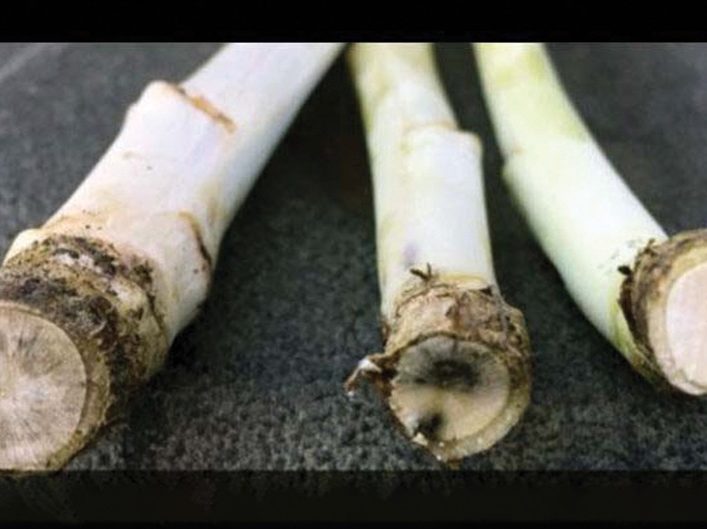
Black specks
As the verticillium infection advances, microsclerotia will start to form on the underside of the peeling stem skin. These can be found all the way up the stem.
Verticillium specks may seem similar to blackleg pycnidia, but they’re much smaller – more like powdery pepper. In some cases, blackleg pycnidia will have a purple-pinkish ooze of pycnidiospores around them. Blackleg pycnidia are also confined to a lesion no more than a few centimetres in size. If you see pink and specks confined to a lesion, it’s blackleg.
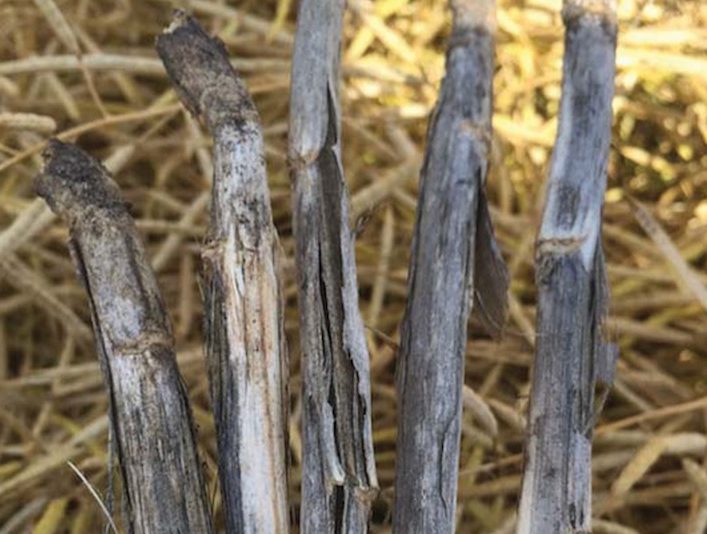
Stem peeling and weakening
Peeling stem skin is a symptom of verticillium stripe. Under that peeled outer layer will be the microsclerotia, often taking the shape of faint black vertical striping.
Severely diseased stems may break off and can be confused with lodging.
Sclerotinia stem rot will also cause weakened, brittle stems, but sclerotinia will not have the stripy, speckly microsclerotia. Sclerotinia stem rot will cause the entire stem tissue to shred, not just the outer layer.
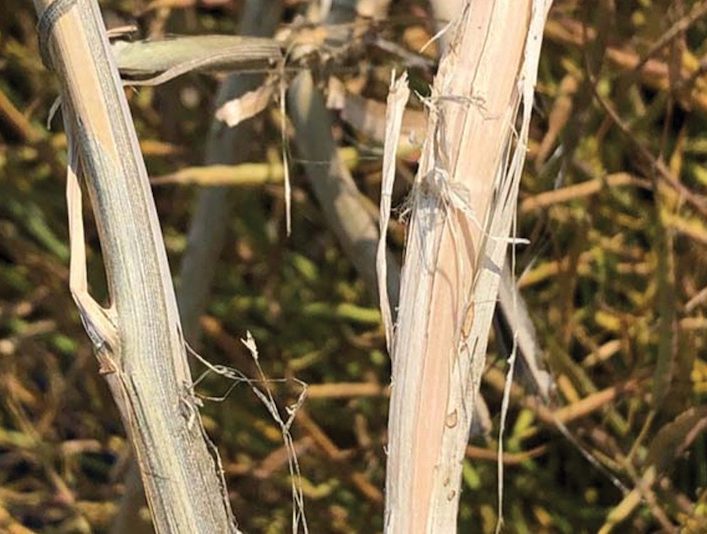
Inside the stem, sclerotinia will form sclerotia bodies – the canola-seed-sized resting bodies. Verticillium stripe does not produce sclerotia bodies.

